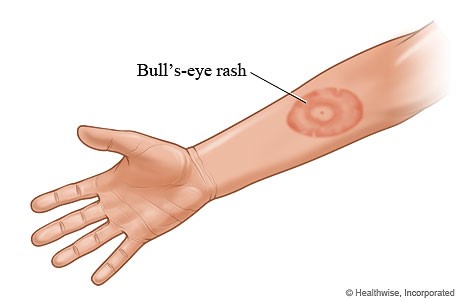What is Lyme Disease?
According to The Center for Disease Control and Prevention, there is an estimated 300,000 people per year diagnosed with Lyme disease. Lyme disease is a type of bacterial infection transmitted by the bite of an infected Ixodes tick<1>. Lyme Disease effects a number of people and species in different regions. This disease is caused by pathogenic bacterium called Borrelia burgdorferi<2>. If not diagnosed early on, the infection may become chronic or even fatal.
What does it do?
The bacteria, Borrelia burgdorferi, manifests in many different bodies, including those of dogs, horses, cattle, deer, mice, chipmunks, opossums, and raccoons. Although these animals may carry the bacteria, it does not have the same effect on them as it does on humans. In general, this bacterium travels through the bloodstream to various tissues of its host. The bacterium doesn’t affect animals the same way as it does humans due to the human immune system’s response to it - basically the bacteria will excite our immune system into defense mode, then can transform to hide from our immune system. Therefore, once the immune system is aware of the intruder, it starts looking for it and the process of not finding it begins to damage other tissues in our bodies<3>
What are the symptoms?
Lyme disease is most common in children who play outside often and young-adults that work outside such as park rangers, fire fighters, farmers, construction workers, and so on. A human bitten by an infected tick should show signs of a tick bite within 24-48 hours, usually a swollen sore similar to an ant bite, with symptoms of Lyme showing such as a bullseye shaped rash called erythema migrans that appears within 3-30 days<4>. Other symptoms include tremors, fever, headache, fatigue, mild confusions, swollen eyes, stiffness, etc. and may often be misdiagnosed as other conditions. Some people who have had the disease reported increased allergies to things that they had not been allergic to before<5>. It has also been said that other tick related diseases may be an indicator for being at risk of Lyme disease. Many may also be infected with Lyme disease and not know it due to misdiagnosis. If you think may be infected, you should get tested for Lyme disease specifically, as the bacteria does not show up in other medical tests.Where are the ticks?
Ticks are most frequently found in warm climates with high humidity. If the climate of an area changes gaining higher temperatures and more rain, the population of ticks in that area will most certainly increase. The most common place in America that Lyme disease infected ticks reside is the northeast region. This map shows the spread of ticks into new counties. Most states have a presence of ticks, however, Lyme disease is most common in Pennsylvania, Massachusetts, New York, New Jersey, Connecticut, and Maine.<6>
How can I prevent tick bites?
Even though ticks are inevitable, there are some ways to avoid having the disease transmitted to you. One major beneficial tip to avoiding ticks is to apply tick repellent. Try to avoid high grass, bushy areas, and places where fallen leaves are prevalent. Ticks do not jump or run to get to you as they are mostly picked up by brushing against branches and kicking up leaves. You can also reduce the likelihood of ticks by wearing long sleeves and pants, tucking your pants into your socks, and wearing light colors to make it easier to spot them. If you suspect you may have been exposed to ticks, be sure to check for them as soon as possible.How can we help?
If you or a loved one is suffering from the pain, discomfort, or fatigue of Lyme disease, there is relief to be found! BeneFab® by Sore No-More offers at-home therapeutic products that will help ease your pain and discomfort. Our products are made up of ceramic infused fabrics that naturally act as an anti-inflammatory. For example, if you are experiencing muscle tightness, fatigue, or general soreness, a therapeutic blanket from BeneFab®, simply laid underneath your fitted sheet where you sleep at night, will increase your circulation, oxygenate your muscles, reduce numbness and tingling, increase your mobility and lessen your pain. Our fingerless gloves, socks, and body wraps all offer the same therapy while targeting a specific area. Check out our full line here. ______________________________________________________________________________ References- https://www.vetmed.wsu.edu/outreach/Pet-Health-Topics/categories/diseases/your-pet-and-lyme-disease
- https://www.lymedisease.org/lyme-basics/lyme-disease/about-lyme/
- https://www.holtorfmed.com/lyme-disease-evade-immune-system/
- http://www.cdc.gov/lyme/signs_symptoms/
- http://www.bayarealyme.org/blog/story/daryl-hall-2/
- http://www.cdc.gov/lyme/stats/tables.html
Photo Credits
- http://vectorecology.org/new-study-updates-an-18-year-old-map-of-tick-distribution-in-us/
- bayarealyme.org
- webmd.com






















